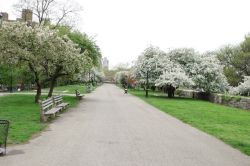Riverside Park
Greenstreet by Riverside Church - Peregrine Falcons in New York City
This greenstreet, located between 102th and 122nd Streets and Riverside Drive, is a prime spot in New York City for sighting peregrine falcons. The reemergence of the peregrine falcon (Falco peregrinus) in North America is one of the environmental movement’s greatest success stories. Until the middle of the 20th century, the crow-sized, dark-capped, blue-gray peregrines ruled the skies and rocky mountaintops from Alaska all the way to Georgia, preying on smaller birds such as sparrows and pigeons. One of nature’s most skilled hunters, the peregrine falcon dive-bombs its prey at speeds of up to 200 miles per hour. Capable of flying at speeds of up to 60 miles per hour in level flight, the peregrine is one of the world’s fastest birds.
But in the 1950s and ‘60s, the chemical dichlorodiphenyltrichloroethane (DDT), used widely in agricultural pesticides, found its way up the food chain. The sparrows, pigeons, and other small birds that peregrines hunted fed on insects contaminated with DDT. Due to the process of biomagnification, DDT accumulated in the peregrines, causing their eggs to become too weak to even support the weight of the mother incubating her eggs. The eggs shattered before fledglings could hatch. By the time DDT was finally banned in 1972, there was not a single peregrine falcon left east of the Mississippi.
When the Endangered Species Act was passed in 1973, peregrine falcons were one of the first species to receive protection. Restoration efforts were launched throughout the 1970s and ‘80s; during that time, 150 young captivity-bred Peale’s peregrine falcons (the eastern peregrine subspecies being extinct) were released in New York State, to reclaim nesting sites in the rocky peaks and crags of the Adirondacks and Hudson River Palisades.
Over the years, peregrines have moved farther and farther into New York City, taking up residences on the exteriors of skyscrapers and bridges. Pairs of peregrine falcons have been found nesting on the window ledges of such buildings as the Metropolitan Life Building (1 Madison Avenue), the Bank of New York (48 Wall Street), and the St. Regis Hotel (2 East 55th Street) in Manhattan. In addition to the Verrazano Narrows and Throgs Neck bridges, peregrines have been seen on the Manhattan tower of the Brooklyn Bridge, as well as on an old gun turret on the Marine Parkway. A peregrine was once even spotted above Times Square. These man-made aeries provide perfect residences for the birds – isolated, easily approachable by air, and with great views of territory and of prey.
By 1999, the peregrine falcon had recovered sufficiently to be moved off the Endangered Species List. Over 145 falcons have been successfully hatched and banded by biologists in New York City since 1983, and have been found raising their own families as far away as Baltimore and Wisconsin.
Check out your park's Vital Signs
Clean & Safe
Green & Resilient
Empowered & Engaged Users
Share your feedback or learn more about how this park is part of a
Vital Park System

Know Before You Go
Related inquiries may be sent to boatbasin@parks.nyc.gov
Related inquiries may be sent to boatbasin@parks.nyc.gov


